Unit 4 Body language (浙江省杭州市临安市)
文档属性
| 名称 | Unit 4 Body language (浙江省杭州市临安市) | 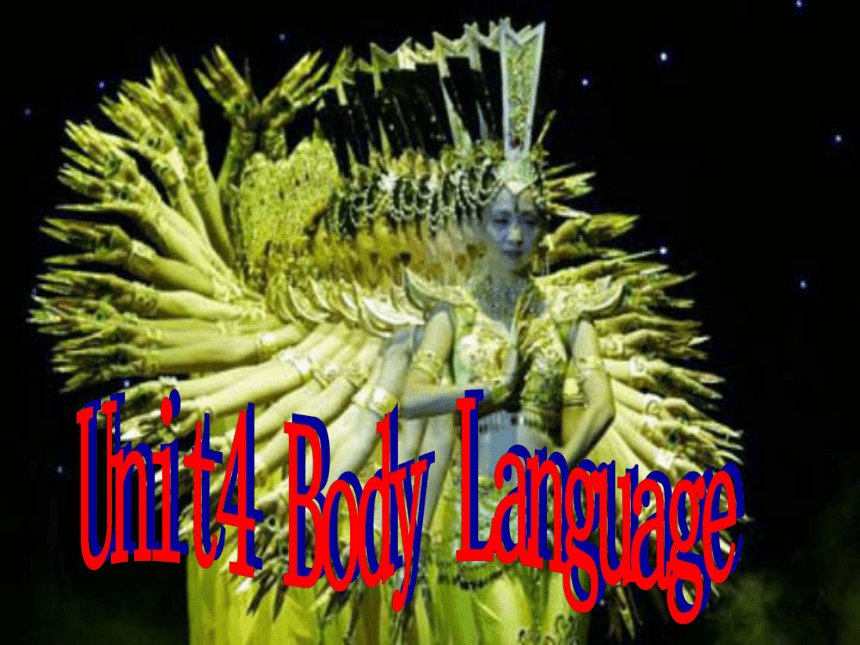 | |
| 格式 | rar | ||
| 文件大小 | 1.8MB | ||
| 资源类型 | 教案 | ||
| 版本资源 | 人教版(新课程标准) | ||
| 科目 | 英语 | ||
| 更新时间 | 2009-06-21 20:49:00 | ||
图片预览


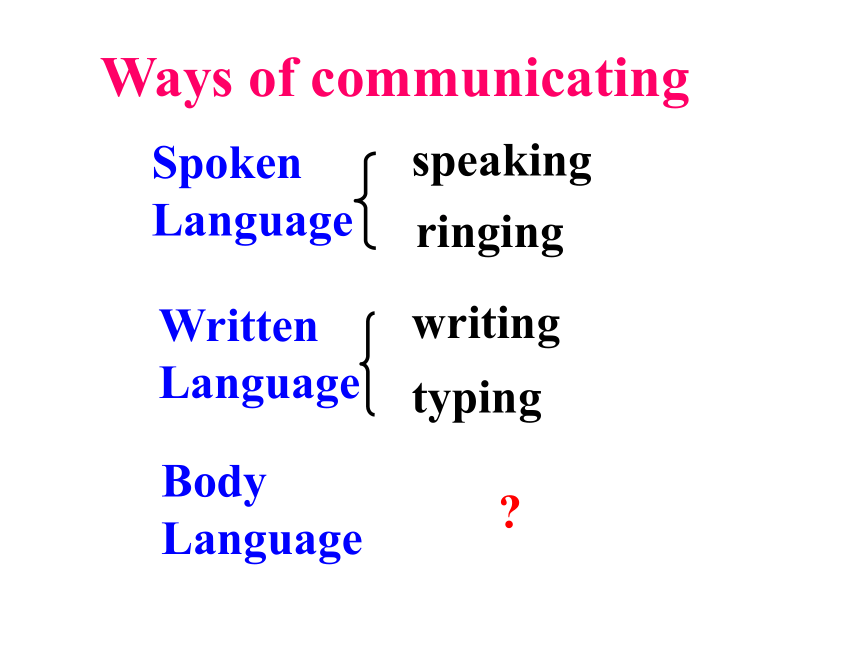
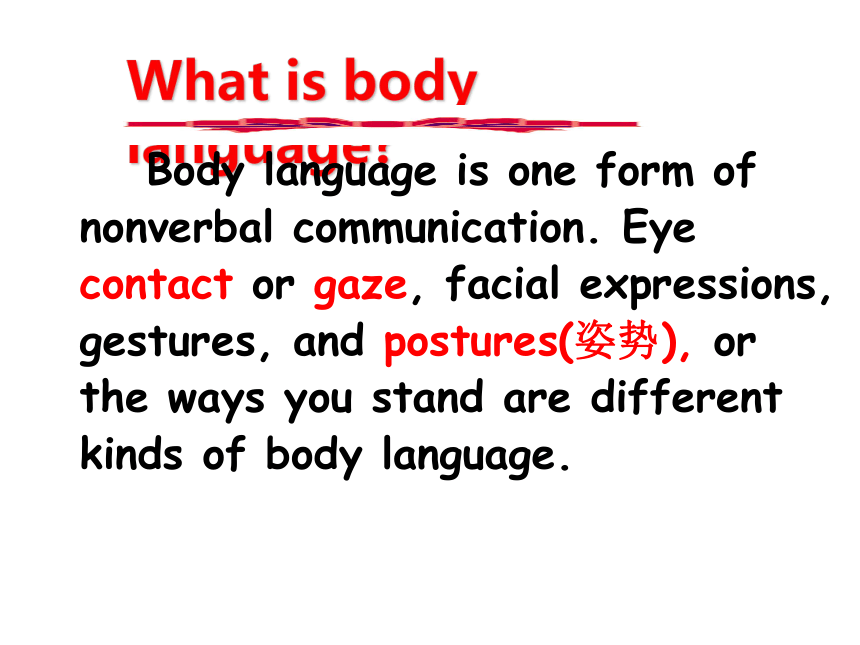
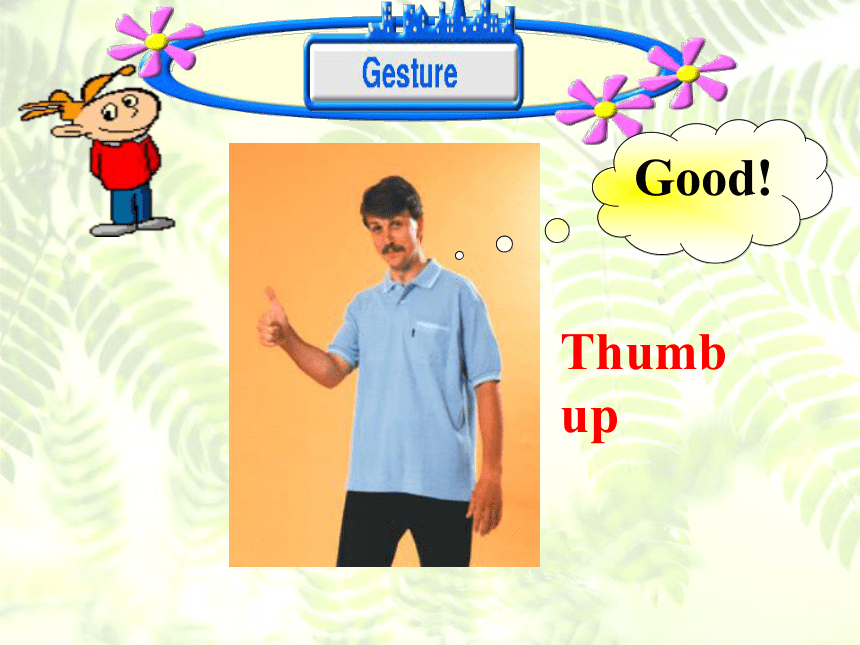
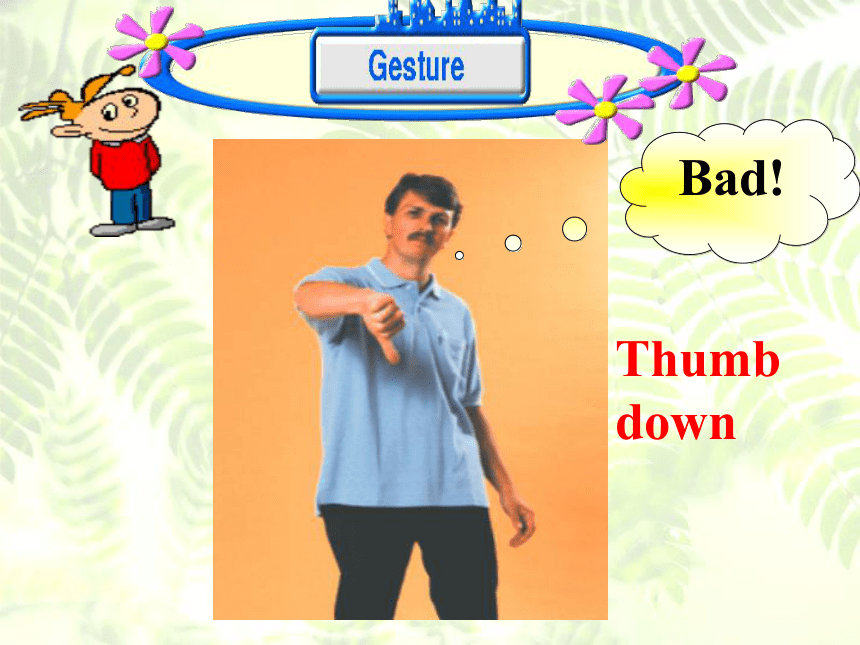
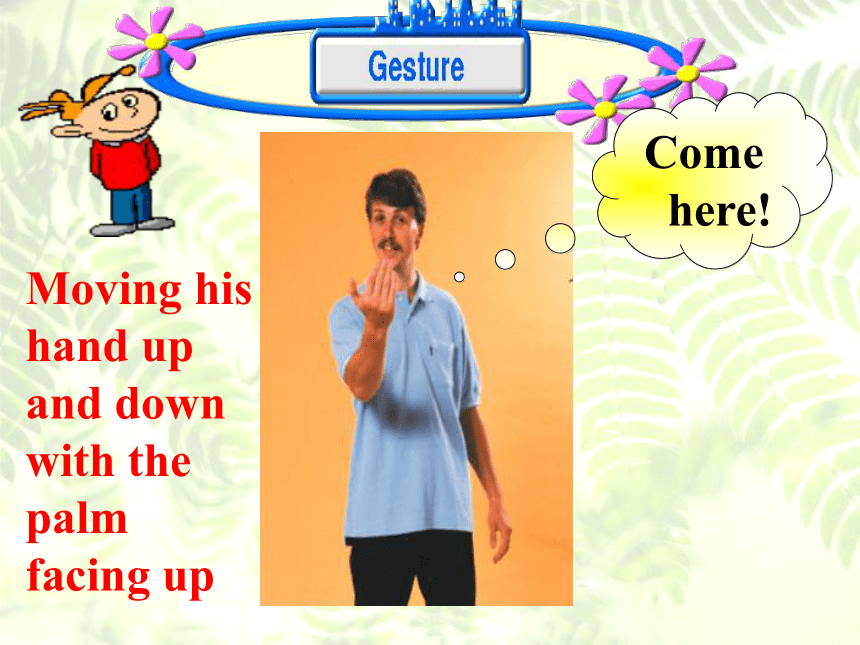
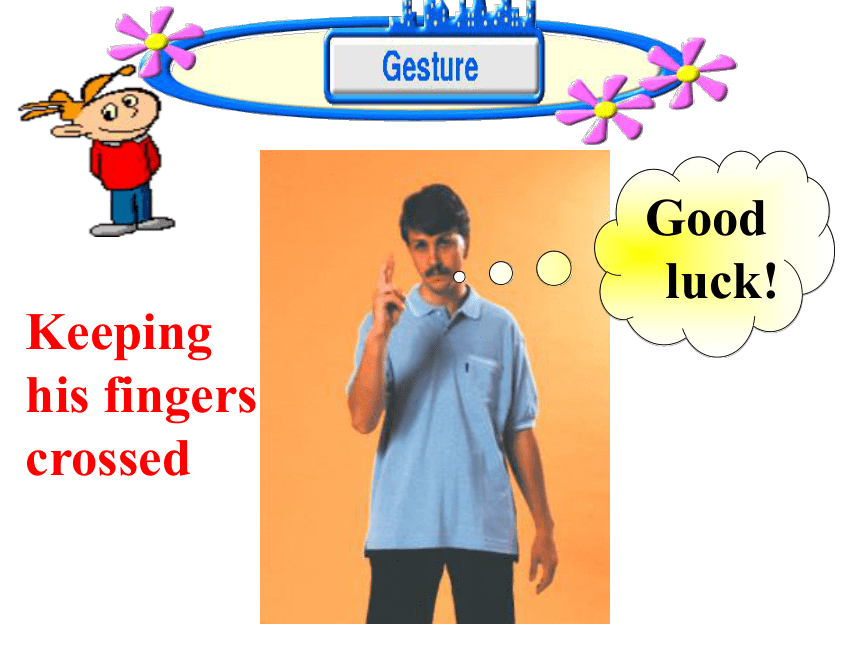
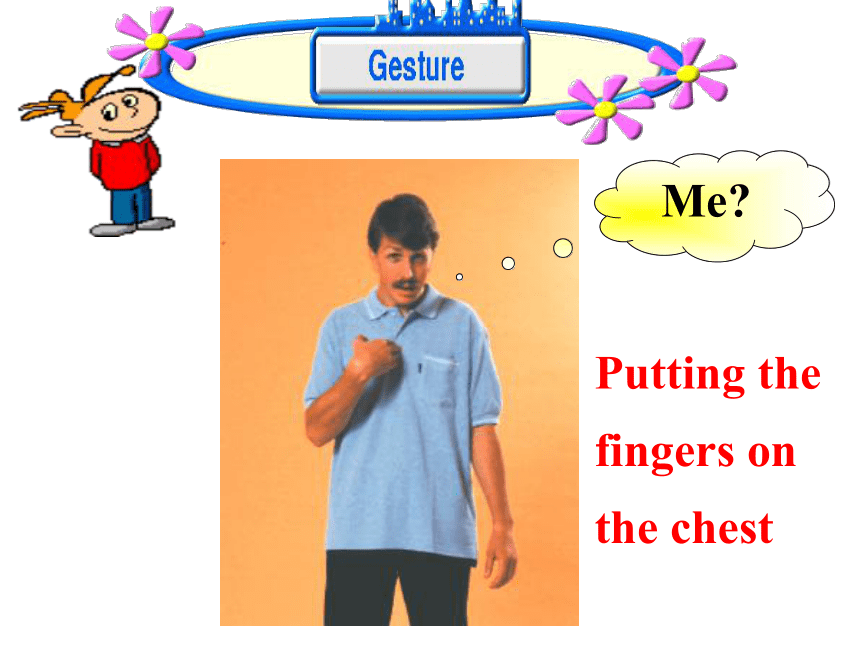

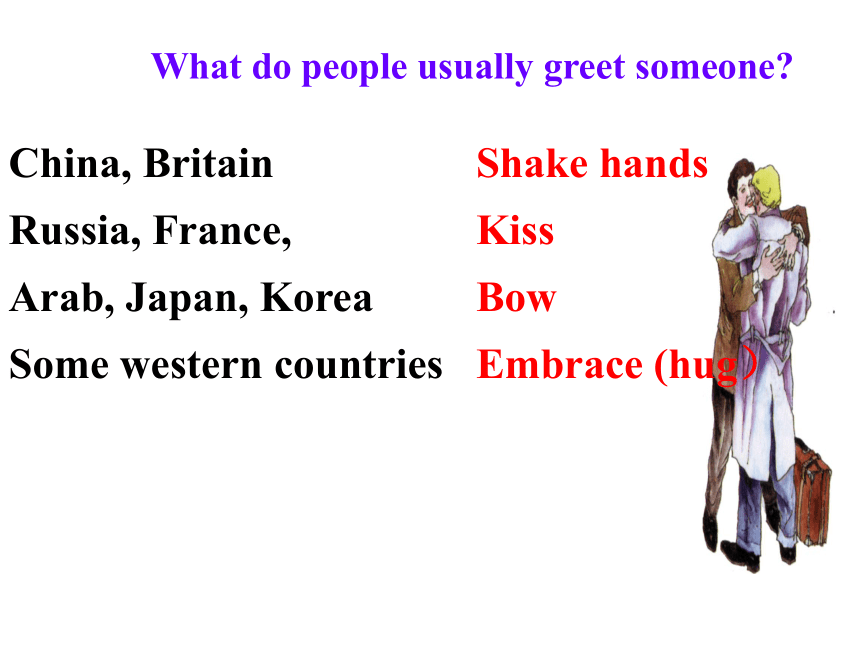
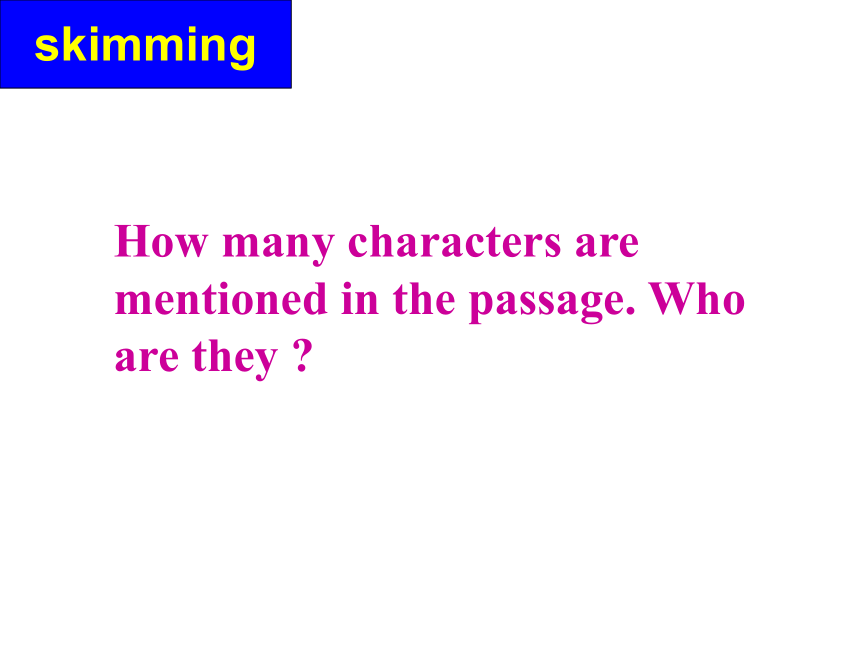
文档简介
课件46张PPT。Unit4 Body LanguagespeakingringingwritingtypingSpoken
LanguageWritten
LanguageBody
LanguageWays of communicating ?What is body language? Body language is one form of nonverbal communication. Eye contact or gaze, facial expressions, gestures, and postures(姿势), or the ways you stand are different kinds of body language.GuessGood!
Thumb upGuessBad!Thumb
downGuessCome here!Moving his hand up and down with the palm facing upGuessGood luck!
Keeping his fingers crossedGuessMe?Putting the fingers on the chestGuessI don’t know!Shrugging his shouldersChina, Britain
Russia, France,
Arab, Japan, Korea
Some western countries Shake hands
Kiss
Bow
Embrace (hug)What do people usually greet someone?skimmingHow many characters are mentioned in the passage. Who are they ?Eight characters.
another student & the author from China
Tony Garcia from Colombia
Julia Smith from Britain
Akira Nagata from Japan
George Cook from Canada
Ahmed Aziz from Jordan
Darlene Coulon from France How do different international students behave when they greet people? Complete the chart with information from the passage.scanning Mr. Garcia (Columbia)Julia Smith (Britain)
George Cook (Canada)a Japaneseman from
Colombiakissing on
the cheekbowingeveryoneeveryoneJulia
SmithAkira
Nagatawoman from
Britainman from
Canadashaking
handsshaking
hands
noddingAhmed
AzizDarlene
Coulonman from
Jordaneveryonewoman
from France people she
knows1 Is the author of this passage male or female? How do you know?
2 What were the two mistakes that the author noticed?
3 Who seemed to prefer to keep more physical distance from others? Who seemed to prefer closer physical distance? careful reading4 Did any students have similar greeting customs? If so, which ones?1 Is the author of this passage male or female? How do you know?The author is male. Ahmed Aziz will not
touch women, but he shakes hands
with the author.Tony Garcia Julia SmithThe first mistakefromfrom(Columbia )(Britain)He approached Julia, _______ ______ _________ and _______ her on the ________.She ______ ________ appearing _________ and ____ ____ her hands, as if in________shouldertouchedherkissedcheekstepped backsurprisedput up2. What were the two mistakes that the author noticed?defenceThe second mistakeAkira NagataGeorge Cookfrom(Canada)He ________ ________ _______ ________ to the Japanese student.He ________ so his nose _________ George’s _______ ________.bowedtouchedmovinghandreached his handoutfrom(Japan)3 Who seemed to prefer to keep more physical distance from others? Who seemed to prefer closer physical distance? The British woman, Julia, seemed to prefer to keep more physical distance from others.
The Colombian man, Tony, and the Jordanian man, Ahmed, seemed to prefer closer physical distance. 4.Did any students have similar greeting customs? If so, which ones? What did they do?Yes. Tony from Colombia and Darlene from France had similar greeting customs
----- kissing and shaking handsGeorge from Canada and Ahmed from Jordan also had a similar greeting custom
----- a handshake, but Ahmed shakes hands only with men5 “ When in Rome, do as the Romans do.” What do you think this famous saying means?This saying means that when we are in
a certain place, we should follow the
customs of the people who live in that
place, not our own customs. Body language is used by people for sending messages to one another. In many countries in the world, men k____ each other when they meet. In Britain, people usually s_____ hands when they meet someone for the first time. They are not comfortable touching s_______. French people kiss each other hello and g______ on the c_____ more often than the British people. People from the USA or Arabian countries stand c_____ than people from Britain when they are talking. They might move very close to you as you i________ yourself to them. Body language is very g______ and not all members of all cultures b______ the same way. Using body language in a correct way will help you to better c___________ with other people.isshaketrangersoodbyeheekloserntroduce eneralehaveommunicateFill in the blanksLanguaga points1. Another student and I , representing our university’s student association, went to meet this year’s international students.represent v. 代表 (stand for),象征,标志;作为示范;
作 为… …的例子representative n. 代理人,代表
adj. 典型的,有代表性的 representation n. 表现,描写;代表,代理represent … as 把 … …描绘成(看作)… …2. I saw several people enter the waiting area looking around curiously.curious---adj. 好奇的, 求知的, be curious about sth 对…感到好奇
be curious to do sth 很想做… 渴望做… curiosity n. 好奇心 out of curiosity 出于好奇
in / with curiosity 好奇地curiously adv. 好奇地3. The first person to arrive was Tony Garcia from Columbia, closely followed by Julia Smith from Britain.closely adv. 接近地,紧紧地closely 与close的区别
close adv. 紧紧地,接近地。强调空间距离近,相当于near; closely也有此意,但语气较强,相当于very near.
closely adv.常用来说明动作以怎样的方式进行。有比喻的用法。意为“亲密地,紧紧地,仔细地,严密地”Stand / sit / live close to +sb. / sth
和某人/某物站得/坐得/住得近4. Mr Garcia approached Julia, touched her shoulder and kissed her on the cheek.approach vt./vi. come near 走近,开始考虑,开始着手, 接近。approach n 接近;方法;途径at the approach of 在快到… …的时候kiss sb. on the cheek 亲吻某人的面颊A. I like his cheek! 我真佩服他的厚脸皮!
B. None of your cheek! 不得无礼!
C. have plenty of cheek 厚脸皮5.Not all cultures greet each other the same way, nor are they comfortable in the same way with touching or distance between people. not 与all, both, every, each 及含every 的合成词连用时,无论not位于这些词的前面还是后面,都构成部分否定,意为“并非所有的… …都… …” I don’t want both the books.
Both windows are not open.
Not every book is educative.
The flower is not seen everywhere.6. People from places like Spain, Italy or South American countries approach others closely and are more likely to touch them.Sb / sth is likely to do sth.
He’s very likely to be late for class.It is likely to rain tonight.It’s likely that 从句It is likely that she will ring me tonight.likely/probable/possible 的区别possible 作表语时不能用人作主语。
It is possible for sb. to do sth.
It is possible +that 从句。probable 作表语时不用人或不定式作主语。
It is probable +that 从句。7. But Ahmed Aziz simply nodded at the two women.nod to do sth. 点头同意做某事
nod in agreement 点头表示同意
with a nod 点一下头8.In general, though, studying international customs can certainly help avoid difficulties in today’s world of cultural crossroads!avoid doing sth.避免做…
Eg: She avoided answering my questions.If you are ____ about Brazil, you may read this book.
A. curious B. upset C. strange D. interested
2. Your experiences are _____ to ours, but your end result is entirely different.
A. same B. different C. similar D. equal
3. As a student, you should try to ____ being late for your class. A. avoid B. refuse C. prevent D. punish
4. ____, A learned man makes fewer mistakes in life than a man without knowledge.
A. In general. B. As general C. On general D. At generalACAA5. Though she has been in England for half a year, she is still unable to ______ in simple English.
explain herself B. express herself
C. speak her mind D. make herself understand
6. --- what do you mean by saying that?
--- I think you ____ what I said. I meant no harm.
A. understood B. misunderstood C. heard D. followed
7.At this time tomorrow, we ___ across the big desert ahead. A. are to drive B. are going to drove
C. will be driving D. will driveBBCUnit 4 Body languageShowing our feelingsHow are they feeling?happysadconfusedboredhatefulfrighteneduneasyeasythrillingconfidentdelightedkindcuriousfeelingsdepressedanger fear joy sadness contempt
轻视 surpriseboredomskimming: find out the general idea of each para.Para. 1
Para. 2
Para. 3
Para. 4
Para. 5
Para. 6
Para. 7Showing happinessShowing unhappiness or angerShowing agreement or disagreement / refusalShowing interest or boredomShowing respectBody language shows all kinds of feelings, wishes and attitudes and often is more important than spoken language.It is great to have some similarities in body language in different culturesScanning: True or FalseBody language is never as important as spoken language.
If you are angry with / at a person, you might turn your back to him or her.
You can threaten a person by refusing to speak.
If you sit looking away from a person, or with your back turned, you are saying you are not interested in that person.
You should not greet your new boss by giving her or him a hug.
Body language is the same all over the world.
Most people can understand each other if they try.TFFTTFTCareful reading: fill in the formNod the head up and downLook away from sb. or yawnAnger Threatening sb.Look at and turn toward sb. or sth.Do not believe or not like somethingSmileLanguage points:1. The most universal facial expression is of course, the smile– its fun_ction is to show happiness and put people at ease.easen. 安逸;舒适;不费力;安心v. 减轻;放松;使舒服ease of mind 心情舒畅
at ease 舒服地,自在地; (口令) 稍息The latest news has eased his mind.
He eased me of the burden.使某人安心;使某人欣慰消除某人的….ease one’s mindease sb. of …put sb at ease 使某人感到轻松自在2. There are many ways around us to show agreement. agreement [U] 同意;意见一致 I'm quite in agreement with what he said[C] 协定;协议reach an agreement 达成协议make an agreement 商定协议3. Looking away from people or yawning will, in most cases, make me appear to be uninterested.
in this / that case
in case of
in case4. Being respectful to people is subjective, based on each culture, but in general it is probably not a good idea to give a hug to a boss or teacher.
5. We can often be wrong about each other, so it is an amazing thing that we understand each other as well as we do!
LanguageWritten
LanguageBody
LanguageWays of communicating ?What is body language? Body language is one form of nonverbal communication. Eye contact or gaze, facial expressions, gestures, and postures(姿势), or the ways you stand are different kinds of body language.GuessGood!
Thumb upGuessBad!Thumb
downGuessCome here!Moving his hand up and down with the palm facing upGuessGood luck!
Keeping his fingers crossedGuessMe?Putting the fingers on the chestGuessI don’t know!Shrugging his shouldersChina, Britain
Russia, France,
Arab, Japan, Korea
Some western countries Shake hands
Kiss
Bow
Embrace (hug)What do people usually greet someone?skimmingHow many characters are mentioned in the passage. Who are they ?Eight characters.
another student & the author from China
Tony Garcia from Colombia
Julia Smith from Britain
Akira Nagata from Japan
George Cook from Canada
Ahmed Aziz from Jordan
Darlene Coulon from France How do different international students behave when they greet people? Complete the chart with information from the passage.scanning Mr. Garcia (Columbia)Julia Smith (Britain)
George Cook (Canada)a Japaneseman from
Colombiakissing on
the cheekbowingeveryoneeveryoneJulia
SmithAkira
Nagatawoman from
Britainman from
Canadashaking
handsshaking
hands
noddingAhmed
AzizDarlene
Coulonman from
Jordaneveryonewoman
from France people she
knows1 Is the author of this passage male or female? How do you know?
2 What were the two mistakes that the author noticed?
3 Who seemed to prefer to keep more physical distance from others? Who seemed to prefer closer physical distance? careful reading4 Did any students have similar greeting customs? If so, which ones?1 Is the author of this passage male or female? How do you know?The author is male. Ahmed Aziz will not
touch women, but he shakes hands
with the author.Tony Garcia Julia SmithThe first mistakefromfrom(Columbia )(Britain)He approached Julia, _______ ______ _________ and _______ her on the ________.She ______ ________ appearing _________ and ____ ____ her hands, as if in________shouldertouchedherkissedcheekstepped backsurprisedput up2. What were the two mistakes that the author noticed?defenceThe second mistakeAkira NagataGeorge Cookfrom(Canada)He ________ ________ _______ ________ to the Japanese student.He ________ so his nose _________ George’s _______ ________.bowedtouchedmovinghandreached his handoutfrom(Japan)3 Who seemed to prefer to keep more physical distance from others? Who seemed to prefer closer physical distance? The British woman, Julia, seemed to prefer to keep more physical distance from others.
The Colombian man, Tony, and the Jordanian man, Ahmed, seemed to prefer closer physical distance. 4.Did any students have similar greeting customs? If so, which ones? What did they do?Yes. Tony from Colombia and Darlene from France had similar greeting customs
----- kissing and shaking handsGeorge from Canada and Ahmed from Jordan also had a similar greeting custom
----- a handshake, but Ahmed shakes hands only with men5 “ When in Rome, do as the Romans do.” What do you think this famous saying means?This saying means that when we are in
a certain place, we should follow the
customs of the people who live in that
place, not our own customs. Body language is used by people for sending messages to one another. In many countries in the world, men k____ each other when they meet. In Britain, people usually s_____ hands when they meet someone for the first time. They are not comfortable touching s_______. French people kiss each other hello and g______ on the c_____ more often than the British people. People from the USA or Arabian countries stand c_____ than people from Britain when they are talking. They might move very close to you as you i________ yourself to them. Body language is very g______ and not all members of all cultures b______ the same way. Using body language in a correct way will help you to better c___________ with other people.isshaketrangersoodbyeheekloserntroduce eneralehaveommunicateFill in the blanksLanguaga points1. Another student and I , representing our university’s student association, went to meet this year’s international students.represent v. 代表 (stand for),象征,标志;作为示范;
作 为… …的例子representative n. 代理人,代表
adj. 典型的,有代表性的 representation n. 表现,描写;代表,代理represent … as 把 … …描绘成(看作)… …2. I saw several people enter the waiting area looking around curiously.curious---adj. 好奇的, 求知的, be curious about sth 对…感到好奇
be curious to do sth 很想做… 渴望做… curiosity n. 好奇心 out of curiosity 出于好奇
in / with curiosity 好奇地curiously adv. 好奇地3. The first person to arrive was Tony Garcia from Columbia, closely followed by Julia Smith from Britain.closely adv. 接近地,紧紧地closely 与close的区别
close adv. 紧紧地,接近地。强调空间距离近,相当于near; closely也有此意,但语气较强,相当于very near.
closely adv.常用来说明动作以怎样的方式进行。有比喻的用法。意为“亲密地,紧紧地,仔细地,严密地”Stand / sit / live close to +sb. / sth
和某人/某物站得/坐得/住得近4. Mr Garcia approached Julia, touched her shoulder and kissed her on the cheek.approach vt./vi. come near 走近,开始考虑,开始着手, 接近。approach n 接近;方法;途径at the approach of 在快到… …的时候kiss sb. on the cheek 亲吻某人的面颊A. I like his cheek! 我真佩服他的厚脸皮!
B. None of your cheek! 不得无礼!
C. have plenty of cheek 厚脸皮5.Not all cultures greet each other the same way, nor are they comfortable in the same way with touching or distance between people. not 与all, both, every, each 及含every 的合成词连用时,无论not位于这些词的前面还是后面,都构成部分否定,意为“并非所有的… …都… …” I don’t want both the books.
Both windows are not open.
Not every book is educative.
The flower is not seen everywhere.6. People from places like Spain, Italy or South American countries approach others closely and are more likely to touch them.Sb / sth is likely to do sth.
He’s very likely to be late for class.It is likely to rain tonight.It’s likely that 从句It is likely that she will ring me tonight.likely/probable/possible 的区别possible 作表语时不能用人作主语。
It is possible for sb. to do sth.
It is possible +that 从句。probable 作表语时不用人或不定式作主语。
It is probable +that 从句。7. But Ahmed Aziz simply nodded at the two women.nod to do sth. 点头同意做某事
nod in agreement 点头表示同意
with a nod 点一下头8.In general, though, studying international customs can certainly help avoid difficulties in today’s world of cultural crossroads!avoid doing sth.避免做…
Eg: She avoided answering my questions.If you are ____ about Brazil, you may read this book.
A. curious B. upset C. strange D. interested
2. Your experiences are _____ to ours, but your end result is entirely different.
A. same B. different C. similar D. equal
3. As a student, you should try to ____ being late for your class. A. avoid B. refuse C. prevent D. punish
4. ____, A learned man makes fewer mistakes in life than a man without knowledge.
A. In general. B. As general C. On general D. At generalACAA5. Though she has been in England for half a year, she is still unable to ______ in simple English.
explain herself B. express herself
C. speak her mind D. make herself understand
6. --- what do you mean by saying that?
--- I think you ____ what I said. I meant no harm.
A. understood B. misunderstood C. heard D. followed
7.At this time tomorrow, we ___ across the big desert ahead. A. are to drive B. are going to drove
C. will be driving D. will driveBBCUnit 4 Body languageShowing our feelingsHow are they feeling?happysadconfusedboredhatefulfrighteneduneasyeasythrillingconfidentdelightedkindcuriousfeelingsdepressedanger fear joy sadness contempt
轻视 surpriseboredomskimming: find out the general idea of each para.Para. 1
Para. 2
Para. 3
Para. 4
Para. 5
Para. 6
Para. 7Showing happinessShowing unhappiness or angerShowing agreement or disagreement / refusalShowing interest or boredomShowing respectBody language shows all kinds of feelings, wishes and attitudes and often is more important than spoken language.It is great to have some similarities in body language in different culturesScanning: True or FalseBody language is never as important as spoken language.
If you are angry with / at a person, you might turn your back to him or her.
You can threaten a person by refusing to speak.
If you sit looking away from a person, or with your back turned, you are saying you are not interested in that person.
You should not greet your new boss by giving her or him a hug.
Body language is the same all over the world.
Most people can understand each other if they try.TFFTTFTCareful reading: fill in the formNod the head up and downLook away from sb. or yawnAnger Threatening sb.Look at and turn toward sb. or sth.Do not believe or not like somethingSmileLanguage points:1. The most universal facial expression is of course, the smile– its fun_ction is to show happiness and put people at ease.easen. 安逸;舒适;不费力;安心v. 减轻;放松;使舒服ease of mind 心情舒畅
at ease 舒服地,自在地; (口令) 稍息The latest news has eased his mind.
He eased me of the burden.使某人安心;使某人欣慰消除某人的….ease one’s mindease sb. of …put sb at ease 使某人感到轻松自在2. There are many ways around us to show agreement. agreement [U] 同意;意见一致 I'm quite in agreement with what he said[C] 协定;协议reach an agreement 达成协议make an agreement 商定协议3. Looking away from people or yawning will, in most cases, make me appear to be uninterested.
in this / that case
in case of
in case4. Being respectful to people is subjective, based on each culture, but in general it is probably not a good idea to give a hug to a boss or teacher.
5. We can often be wrong about each other, so it is an amazing thing that we understand each other as well as we do!
同课章节目录
